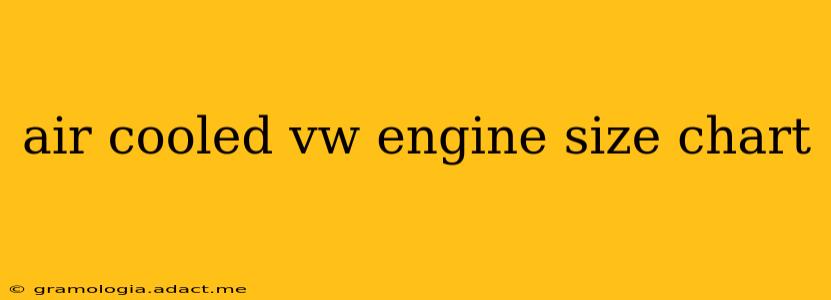The air-cooled Volkswagen engine, a symbol of automotive history and ingenuity, boasts a fascinating range of displacements. This chart provides a comprehensive overview of the various engine sizes, encompassing both the iconic Beetle and other models that utilized this technology. Understanding these engine sizes is crucial for enthusiasts, mechanics, and anyone interested in the rich history of these legendary powerplants. We'll delve into the specifics, addressing common questions along the way.
Common Air-Cooled VW Engine Sizes
The most recognizable air-cooled VW engines fall into several distinct displacement categories, typically expressed in cubic centimeters (cc) or liters (L). While there were variations and modifications throughout the years, these are the key engine sizes:
| Engine Code | Displacement (cc) | Displacement (L) | Horsepower (approx.) | Notes |
|---|---|---|---|---|
| 1100 | 1192 | 1.2 | 34-40 | Early Beetle, Type 1 |
| 1200 | 1200 | 1.2 | 36-44 | Common in early Beetles and Buses |
| 1300 | 1285 | 1.3 | 44-50 | Increased displacement for improved performance |
| 1500 | 1493 | 1.5 | 50-60 | Popular in later Beetles, Buses, and Karmann Ghias |
| 1600 | 1584 | 1.6 | 50-66 | Widely used in various models; numerous variants existed |
| 1641 | 1641 | 1.6 | 60-70 | A more powerful variant of the 1600 |
| 1776 | 1776 | 1.8 | 70-90 | Often found in modified or performance-tuned vehicles |
| 2000 | 1970 | 2.0 | 80-110 | Typically used in larger, heavier models or performance applications |
Note: The horsepower figures are approximate and can vary based on year, model, and modifications.
What are the differences between the different engine sizes?
The differences between the various engine sizes primarily relate to displacement and, consequently, power output and torque. Larger displacement engines generally produce more power and torque, leading to better acceleration and higher top speeds. However, larger engines might also be less fuel-efficient. The differences in engine design across these displacement levels were often subtle, frequently involving changes in cylinder bore, stroke, and carburetion to achieve the desired power output.
How do I identify the engine size of my air-cooled VW?
The most reliable way to identify the engine size is by checking the engine number stamped on the engine case itself. This number typically contains codes that indicate the displacement and year of manufacture. Supplementing this with the vehicle identification number (VIN) can also help determine the original engine specifications. Owner's manuals and VW parts catalogs can also provide valuable assistance in confirming the engine size.
What are the common issues with air-cooled VW engines?
Air-cooled VW engines, while robust, are prone to certain issues due to their unique design. These include:
- Cooling System Problems: Overheating is a significant concern. Proper cooling fin maintenance, proper air circulation, and correct oil level are critical.
- Oil Leaks: Oil leaks are common, often stemming from worn seals and gaskets.
- Electrical Issues: The ignition system can be susceptible to problems, particularly with age.
- Carburetion Issues: Correct carburetor tuning is essential for optimal performance and fuel economy.
Are air-cooled VW engines reliable?
With proper maintenance, air-cooled VW engines can be surprisingly reliable. Their simple design and readily available parts contribute to their longevity. However, preventative maintenance is crucial. Regular oil changes, inspections, and addressing minor issues promptly can help avoid more significant and costly repairs.
This guide provides a foundational understanding of air-cooled VW engine sizes. For more specific information, consult specialist literature or online resources dedicated to these iconic engines. The community surrounding air-cooled VWs is vast and supportive, offering a wealth of knowledge and expertise for any owner or enthusiast.
